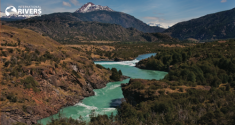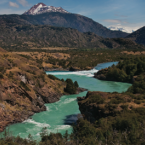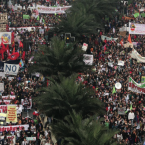Patagonia's Rivers at Risk
A consortium of Chilean and European companies called HidroAysén hopes to dam two of Patagonia’s wildest and most remote rivers – the Baker and Pascua.They also propose to build a 2,000-km transmission line to export the electricity from Patagonia to feed Chile’s mammoth mining industry and biggest cities in the center of the country.
The Baker and Pascua rivers are located in Aysén, Chile’s most sparsely populated region.The Pascua River literally jumps out of Lago O’Higgins into a series of class-6+ rapids and waterfalls, making it one of the most rapidly flowing rivers on the planet. Pristine freshwater from the jagged peaks and glaciers of Patagonia’s Southern Ice Cap churns its way through a maze of canyons into the Pascua.
The Baker River, also born of Patagonian glaciers, is Chile’s most powerful river.The Baker sustains some of Patagonia’s most productive ranching lands, and supports a thriving sport-fishing business and burgeoning river-rafting industry.Tourism on the Baker River has brought sustainable income to the region of Aysén.
Aysén’s stunning scenery and rare endemic ecology have led local citizens to declare the region a “reserve of life.” For the Patagonian people,Aysén is a bastion for a pastoral way of life that is rapidly disappearing. Ayseninos know that these dams would be the beginning of the end to their local culture and identity.
The Profiteers, The Price – and The Costs
The mega-companies behind HidroAysén hope to see large profits from the Patagonia dams and transmission lines.The HidroAysén consortium is planning five dams – two on the Baker and three on the Pascua – whose 2,750 MW proffers to provide approximately one-fifth of the total installed capacity projected for the central grid by 2020.
Two rich and powerful Chilean families – the Matte Group and Angelini Group – together control Colbún, HidroAysén’s Chilean partner. Enel – Italy’s biggest electric utility – controls Endesa Chile, HidroAysén’s European partner.To move the dam and transmission plans forward, these huge corporate owners of HidroAysén would need to raise serious money. The current estimate for the total cost of the dams and transmission lines has risen to US$10 billion.
HidroAysén has run an expensive ad campaign, claiming its plans would bring “clean” energy to Chile. But their definition of clean ignores the many environmental and social costs of the proposed dams and destructive transmission lines. These costs include displaced families, disrupted traditional livelihoods, divided communities, spoiled local tourism, damaged forests and endangered species.The latest route for the transmission line is currently unknown, but it could require the world’s longest clearcut – covering thousands of hectares – through ancient temperate rainforests and other forest types unique to Patagonia. Earlier published routes of the line saw it slashing through many Chilean communities and damaging spectacular Chilean protected areas such as Hornopirén National Park and Corcovado National Park.
The dams and transmission lines together would threaten numerous aquatic, bird and mammal species already at risk. The Aplochiton (zebra fish), the torrent duck, the Chilean river otter and an endangered Chilean deer, the huemul – of which less than 3,000 survive today – would all be brought closer to extinction.
A massive seaport would be built on a fjord near the mouths of the Baker and Pascua rivers to facilitate the construction activities, and new roads would be built. In addition, thousands of construction workers would be brought in to build the port, the dams, the roads and other new infrastructure.They would likely bring pollution, crime, prostitution, and housing
problems to the area.The invasion of this “boom and bust” non-local construction economy is incompatible with Aysén’s traditional way of life.
Corporate Irresponsibility and Conflict of Interest
HidroAysén first submitted its Environmental Impact Assessment (EIA) in August 2008.The EIA was supposed to present enough information so that Chilean government departments could determine the likely environmental and social impacts of HidroAysén’s plans. All 32 of the government departments that reviewed the EIA found that it presented such insufficient or erroneous information that they were unable to properly assess the project. Legally, the EIA should have been rejected. Instead, buckling under political pressure, the regulator gave HidroAysén a nine-month extension to address all 3,000+ identified problems.After many additional deadlines and government agency reviews, three lengthy addenda were submitted to address the serious flaws and omissions in the EIA.
On May 9, 2011, an environmental review commission – comprised of commissioners appointed by the pro-dam government – approved the HidroAysén EIA by a vote of 11-1. Much controversy surrounded the vote, as several commissioners excused themselves due to conflicts of interest, while others should have excused themselves but refused to do so.
The conflict of interest goes even deeper. President Piñera’s brother-in-law is not only the Assistant Director of HidroAysén, but is also the Manager of Engineering and Electric Projects for Colbún, which controls 49% of the HidroAysén consortium. Laurence Golborne, Minister of Mines and Energy, was offered the position of Director of HidroAysén before he became Minister.
Several of the regional ministers involved in approving the project worked as contractors for HidroAysén in the past.And the foundation headed by President Piñera’s wife received a donation of €100 million from the Endesa Foundation in late April 2011, just weeks before the EIA was approved; Endesa controls 51% of HidroAysén.
Even with the addenda, outstanding issues with the EIA remain.These include unanswered questions submitted by citizens and the illegal shortening of the public comment period – now the topic of an investigation by the Congressional Commission of Human Rights. Other outstanding questions include the lack of settlement agreements with affected people; and the absence of critical information such as correct baseline data, a full assessment of the areas that would be affected by the dams, the effects on local flora and fauna such as the endangered huemul deer, and the use of incorrect data and assumptions to measure and assess reservoir sedimentation and glacial hazards such as Glacial Lake Outburst Floods (GLOFs).
Another deceptive move on the part of HidroAysén is the decoupling of the approval of the dams from the transmission lines. Neither is viable without the other, but project proponents were able to submit separate EIAs in the hope of gaining easier approval for each one. HidroAysén is expected to submit the transmission line EIA by December 2011.The company has been actively lobbying Congress to fast-track the approval process for transmission lines in Chile by weakening EIA requirements. At this time, it seems unlikely that this will pass since a number of congress members oppose HidroAysén.
Approval of the EIA for the transmission lines will be even more difficult to obtain and will likely take longer than the dams’ EIA.The lines would affect thousands of Chileans as it crosses nearly half the country.The lines would require 5,000 transmission towers, each at least 70 m high, with a 100-m-wide clearcut corridor running the entire length. Due to the type of lines required to carry electricity such a long distance, no power would be available for local use.
A Better Way Forward
Chile’s environmental impact assessment system does not require any consideration of viable alternatives to the proposed project. Nevertheless, Roberto Román, Mechanical Engineer at the University of Chile, and Stephen Hall of Sustainable Energy International in Santiago have shown in a recent study that Chile could meet its energy needs through at least 2025 with energy efficiency and new renewable energy sources, with no need for more coal plants or HidroAysén. In fact, renewables and energy efficiency would be capable of providing up to 35% of total demand in 2025.These diverse energy sources would also reduce Chile’s vulnerability to energy disruption from drought, increase the quality of energy services, lower consumer prices, and improve competition and productivity of energy companies.
Although the Chilean government projections show an annual growth in energy demand of 5.8%, Hall and Román have shown that a more realistic growth rate is 4.5%.Thus energy demand will not double by 2020 as the government claims, nor are there risks of an energy crisis given that the government has already approved projects that largely surpass demand. Even with a 5.8% annual growth rate, if renewables and energy efficiency were implemented, half of the already approved coal plants and HidroAysén would be unnecessary. In fact, this excess capacity would bring higher electricity costs and less productivity.
The Patagonia Sin Represas Movement
A strong national and international grassroots campaign opposes HidroAysén’s plans to dam the Baker and Pascua rivers.The banner of Patagonia Sin Represas – Patagonia Without Dams – has come to include the majority of Chileans both at home and abroad and their supporters who oppose HidroAysén and the destructive development it represents.The Consejo de Defensa de la Patagonia – Council in Defense of Patagonia – coordinates campaign activities in Chile, the US, Spain and Italy.
According to an IPSOS opinion poll in April 2011, 61% of Chileans oppose the construction of dams in the Aysén region.A 2009 referendum held by the community of Caleta Tortel – at the mouth of the Baker River – found that 78% of voters do not agree with the project.
Widespread protests against this project began even before the EIA was approved. On April 26, 2011 thousands protested in front of the presidential building and at least nine other cities. On the day of the Environmental Review Commission vote, protests began instantaneously once approval was granted.That night, thousands of people took to the streets in Santiago and other cities across the country.
Protests continued to grow throughout May 2011, with 40,000 people in the streets of Santiago the day before President Sebastian Piñera’s State of the Union address; 35,000 turned out to meet the president the next day for his speech inValparaíso.That weekend, events were held in nearly every city in Chile, plus locations around the world by Chilean expats and their supporters. On May 28, an estimated 50,000 – 90,000 people peacefully demonstrated in the streets of Santiago for a Patagonia Sin Represas – the largest protest the country had seen since the end of the Pinochet dictatorship.
The HidroAysén project has become a national issue, sparking a massive call for more transparent and sustainable energy planning, an end to monopoly control of Chile’s electricity system, and investment in truly renewable and sustainable energy.The project has become a serious political burden for President Piñera and other government officials.
HidroAysén has a legacy that goes back to the dictatorship’s corrupt ways – another shortcoming in the scheme that is fueling the protests.The gift of the water rights for the Baker and Pascua rivers was one of General Pinochet’s last acts before he left power; the water rights were given away to government entities, which were soon privatized.These corporations are now hoping to directly benefit from the dictatorship that left this country politically divided still today.
The world is coming together to support the Chilean call: NO to HidroAysén,YES to a safe, reliable, and sustainable energy future for Chile.










